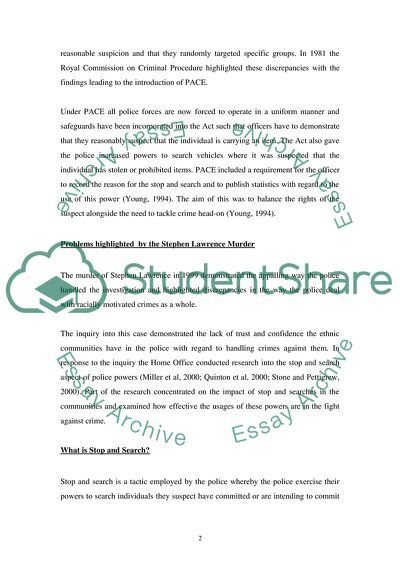
- Home
- Free Samples
- Premium Essays
- Editing Services
- Extra Tools
- Essay Writing Help
- About Us
- Studentshare
- Subjects
- Miscellaneous
- Are The powers the police have to stop ,search and arrest members of the public controversial and discriminatory Discuss
Are The powers the police have to stop ,search and arrest members of the public controversial and discriminatory Discuss - Essay Example

- Subject: Miscellaneous
- Type: Essay
- Level: Undergraduate
- Pages: 4 (1000 words)
- Downloads: 0
- Author: elmer02
Extract of sample "Are The powers the police have to stop ,search and arrest members of the public controversial and discriminatory Discuss"
There have always been difficulties with regard to the powers of the police as laid down within PACE. The 1981 riots in Brixton demonstrated the police use of force against ethnic minority groups. Many of the complaints have come from ethnic minorities and black communities where the incidence of people being stopped and searched is significantly higher than for white people. Research confirms these allegations (Smith, 1983; Willis, 1983; Bucke, 1997). Statistics produced by the Home Office in 1999 also show a significant difference in the number of searches of black people compared with white people (Home Office, 1999).
Some have blamed this difference on police discrimination whilst others claim that there is a higher rate of offending amongst black communities. Before the introduction of the Police and Criminal Evidence Act 198 powers to search were contained within local and national legislation (Brown, 1997). In London s66 of the Metropolitan Police Act 1839 conferred the right on officers to stop and search persons suspected of carrying drugs, firearms and stolen goods. Willis (1983) concluded from his studies that officers generally did not abide by the requirement of reasonable suspicion and that they randomly targeted specific groups.
In 1981 the Royal Commission on Criminal Procedure highlighted these discrepancies with the findings leading to the introduction of PACE. Under PACE all police forces are now forced to operate in a uniform manner and safeguards have been incorporated into the Act such that officers have to demonstrate that they reasonably suspect that the individual is carrying an item. The Act also gave the police increased powers to search vehicles where it was suspected that the individual has stolen or prohibited items.
PACE included a requirement for the officer to record the reason for the stop and search and to publish statistics with regard to the use of this power (Young, 1994). The aim of this was to
...Download file to see next pages Read MoreCHECK THESE SAMPLES OF Are The powers the police have to stop ,search and arrest members of the public controversial and discriminatory Discuss
The Law on Search and Seizure
The Racist Practices
The Common Wonders of Garcia Marquez's Recent Fiction
Race Viewed In Connection To Violence Ten Years Ago And Now
The USA Patriot Act
How Was Race Viewed in Connection to Violence Ten Years Ago and How Is It Viewed Today
Relationship Between Communities
Deaths in Custody Are a Controversial Issue a Critical Approach in Relation to Race and Police or Prison Custody

- TERMS & CONDITIONS
- PRIVACY POLICY
- COOKIES POLICY